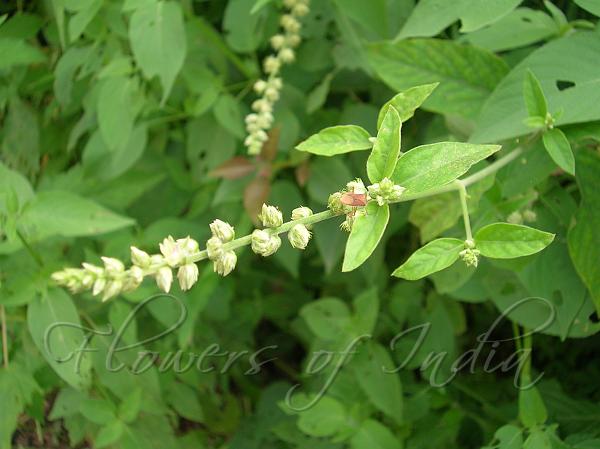|
| Forest Burr |
|

|

| File size | 1082035 |
| Original date | 8/16/08 4:37 PM |
| Resolution | 2048 x 1536 |
| Flash | Flash did not fire, auto |
| Focal length | 8.0mm |
| Exposure time | 1/82s |
| Aperture | 3.2 |
| Focus Distance | |
| Metering Mode | Partial |
| Camera make | NIKON |
| Camera model | E3700 |
| Sensor type |
|
|
|
|
Photo: |
Botanical name: Pupalia lappacea Family: Amaranthaceae (Amaranth family)
Synonyms: Achyranthes lappacea
Synonyms: Achyranthes lappacea
Forest Burr is a perennial herb, erect or prostrate
and sprawling, 60-90 cm tall. Branches and leaves opposite, variously
hairy. Leaves variable in shape and size, from narrowly ovate-elliptic
to oblong or round, 2-12 x 1-6 cm, tapering to apiculate at the
tip, shortly or more longly wedge-shaped at the base, narrowed to
a stalk 2-25 mm long. Flower-spikes are at the end of the stem
and branches, at first dense, elongating to as much as 50 cm in
fruit. Inflorescences greyish-white, in racemes, the clusters alternate
and well-spaced. hermaphrodite flowers mostly in ± stalkless clusters
of 3, upper often solitary; bracteoles of hermaphrodite flowers broadly
heart-shaped-ovate, 2.75-5 mm, prominent, sharply with a short sharp
point with the percurrent midrib. Tepals oblong, 3.5-6 mm, hairless to
± hairy dorsally, 3-nerved, the lateral nerves of the 2 outer tepals
strong throughout, joining the shortly excurrent midrib just below the
tip. Spines of modified flowers hairless except sometimes near the base,
yellowish to purple, 3-4 mm; 3-flowered clusters falling together to form
a “burr” up to 2.5 cm in diameter. Filaments 2-3 mm. Style slender,
1.25 2 mm. The fluffy fruits are balled and used to filter milk etc.
| Identification credit: Navendu Pāgé, Shaista Ahmad | Photographed at Green Park City Forest, Delhi & Karighatta Hill, Karnataka. |
• Is this flower misidentified? If yes,